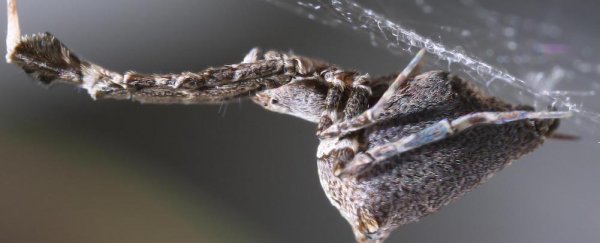Scientists have long been interested in tapping into the potential of spider silk. It's lightweight, flexible and super-strong, and has already found applications in things ranging from bullet-proof textiles to surgical stitches and biomedical implants.
Understanding how spiders naturally produce such thin fibres could also lead to new advances in manufacturing and materials science, as researchers strive to develop improved polymer-fibres for composites.
Many spiders produce silk threads that are several micrometres thick - but some can produce fibres that are even thinner.
The garden centre spider, Uloborus plumipes, is what's known as a cribellate spider.
This relatively small, non-venomous spider is commonly found in greenhouses around the UK and has what's known as a cribellum - a type of silk-spinning organ, consisting of one or two plates covered with densely packed nozzles (or spigots). Silk is produced inside the glands attached to these nozzles.
This organ allows the Uloborus to produce ultra-fine filaments that measure on the nano-scale. It also means that, instead of spinning wet silk, laced with a glue-like substance, it produces a silk that is completely dry.
The Uloborus' silk and has been described as being fluffy and wool-like. It is also thought that the spinning process causes it to be electrically-charged - a feature that might improve its stickiness.
To discover the secrets behind this complex nanofibre production process, zoologists from Oxford University in the UK took photographs and videos of the spiders' silk-spinning in action. They also examined the process using three different microscopy techniques, paying close attention to the cribellum.
They have described the process in the journal Biology Letters.
"Uloborus has unique cribellar glands, amongst the smallest silk glands of any spider, and it's these that yield the ultra-fine 'catching wool'," said lead author Katrin Kronenberger in a press release.
The raw material, known as silk dope, is funnelled through narrow ducts into tiny spinning nozzles or spigots, Kronenberger said.
But rather than pre-forming into filaments inside the ducts - like other spinning-systems that have been examined - the threads created by the garden centre spiders remain in liquid form, solidifying only just before they emerge from the nozzle.
As thousands of nano-scale filaments emerge from each of the densely packed nozzles, the spider violently pulls at them to create a single thread, which becomes electrically charged as it passes through comb-like hairs on the spiders' legs.
"The extreme thinness of each filament, in addition to the charges applied during spinning, provides Van der Waals adhesion. And this makes these puffs immensely sticky," said co-author Fritz Vollrath in a statement.
"Studying this spider is giving us valuable insights into how it creates nano-scale filaments," said Professor Vollrath.
"If we could reproduce its neat trick of electro-spinning nano-fibres we could pave the way for a highly versatile and efficient new kind of polymer processing technology."
SOURCE: Smithsonian.com
